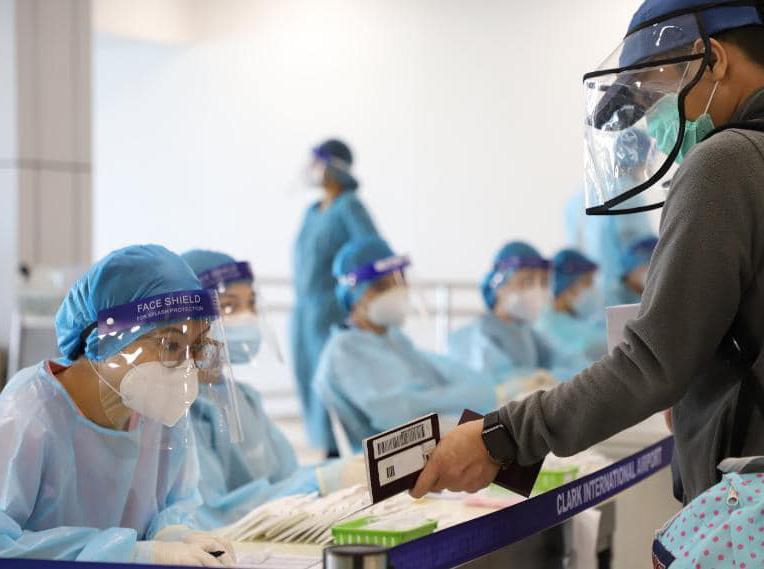
4 minute read
A SOFT PLACE TO LAND
by BCDA
Nearly completed, a new terminal building is expected to triple Clark International Airport’s annual passenger capacity.
OPPOSITE PAGE: Returning OFWs underwent quick and efficient processing in Clark during the lockdown; the airport’s roof design was inspired by the Sierra Madre mountain range.
When the COVID-19 pandemic swept the world and halted all air travel, Clark International Airport became a safe haven for stranded passengers and repatriated overseas workers.
By Peejo Pilar and Micah Sulit Photographs by Borj Meneses (CDC Communications Department) and Joseph Pascual
housands of local and international travelers were stranded in airports across the country when the whole of Luzon was first placed on lockdown on March 17, 2020. Travel by land, air, and sea was severely restricted. Outbound passengers had to fly out of international airports in Luzon within 72 hours, while inbound flights to Manila were rerouted to places like Cebu. Domestic flights were immediately cancelled and international flights followed soon after. Even among passengers who had just landed, many couldn’t get to their home provinces because there were no connecting flights.
At Clark International Airport (CRK), some 90 kilometers from Metro Manila, over 200 passengers were stranded for days. Most of them were returning overseas Filipino workers (OFWs) who had no way to go home to their families.
Help quickly arrived in the form of Task Force Clark Safe Haven, a joint initiative by the Bases Conversion and Development Authority (BCDA), Clark Development Corporation (CDC), Clark International Airport Corporation (CIAC), and LIPAD Corporation, which manages the airport.
With support from various government agencies and local authorities in Pampanga, the task force provided the stranded passengers with free food and lodging. The beleaguered travelers were put up in Clark hotels while riding out the lockdown restrictions in their destinations.
It wasn’t exactly an ideal summertime vacation, but it was a comfortable stay. “We couldn’t have found a much better place to be stranded,” said Magnolia FernandezYrasuegui, a Davao-based radio station manager who had flown back from the US with her husband. “We thank God it is here in Clark. The amenities are great. The room is comfortable and staying here makes our situation lighter to bear.”
Two months after its commercial flights

were suspended, CRK opened its gates again on June 5, 2020 because of the increasing numbers of repatriated OFWs arriving in Manila as worldwide lockdowns went on. “We opened the Clark airport to decentralize the arrival of our OFWs so that they will be more comfortable,” said BCDA President and CEO Vince Dizon. “Our objective is that they will know their COVID-19 test results in five days. If they are negative, they can go home.”
Soon after resuming operations, CRK emerged as a convenient and efficient entry point for returning OFWs. A one-stop-shop facility was set up for disembarking passengers to fill out necessary forms and undergo mandatory reverse transmission–polymerase chain reaction (RT-PCR) tests for COVID-19. They were then brought to hotels in Clark for a free stay while waiting for their test results. Once they were given a clean bill of health, they were free to go.
Swabs were sent to COVID-19 testing centers near the airport, such as the Philippine Red Cross Bio-molecular Laboratory, which has the capacity to test as many as 2,000 samples a day, and the stateof-the-art Asian Development Bank–funded Molecular and Diagnostic Pathology Laboratory at the Jose B. Lingad Memorial General Hospital in San Fernando, Pampanga. This made for a faster turnaround of lab results.
In June alone, CRK serviced 24 inbound and outbound international flights in total and helped more than 5,000 OFWs return to their homes. These balikbayans were flown in from various parts of the world, including Dubai, Doha, Madrid, and the Caribbean island-nation of Barbados.
It’s not surprising that CRK provided returning OFWs with the most comfortable homecoming possible during a truly harrowing time. With Manila’s Ninoy Aquino International Airport having long suffered from air traffic congestion, the vision for CRK has always been to transform it into one of the country’s premier gateways, especially for international tourists. With multiphase development plans that hinge on modernity, sustainability, and convenience, it’s been designed all along to become the traveler’s airport of choice.


Passengers will soon enjoy an enhanced travel experience at Clark International Airport’s new terminal.
In July, the Department of Transportation announced that the new passenger terminal building at Clark International Airport (CRK) was 99% complete. Once the facility is fully operational in early 2021, it will more than quadruple the airport’s total floor area and increase CRK’s annual capacity from 4 to 12 million passengers. In the future, the airport will also be connected via railway to Manila, slashing the travel time down to less than an hour.
The new CRK terminal isn’t just designed for convenience and connectivity. It’s also built to be disaster-resilient, environmentally friendly, and overall a gorgeous example of Philippine architecture. Mount Arayat, a prominent landmark in Pampanga, and the Sierra Madre mountain range inspired the building’s eyecatching undulating roof.










